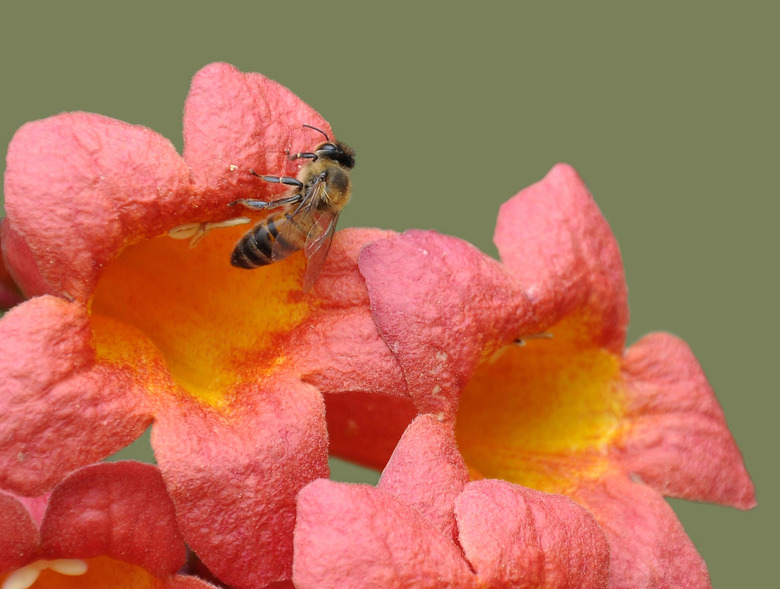How To Grow Tangerine Beauty Crossvine
Tangerine Beauty crossvine (Bignonia capreolata "Tangerine Beauty") earned its name with its vibrant, orange-pink flowers, which feature a brilliant yellow throat. It adapts readily to a variety of growing conditions, making it a versatile and low-maintenance addition to native plant landscaping. Growing Tangerine Beauty crossvine takes little effort but yields great rewards. However, its growing needs must be met to bring out its full potential.
Step 1
Tangerine Beauty crossvine performs well within U.S. Department of Agriculture plant hardiness zones 5 to 9, although its hardiness varies and it needs a little extra help in colder areas. It may die back to the roots in winter if left uncovered in USDA plant hardiness zone 5. However, it will re-sprout in spring after soil temperatures warm. Surround Tangerine Beauty crossvine with a 3-inch layer of mulch all winter long, and cover it with breathable, lightweight cloth if temperatures below 29 degrees Fahrenheit are forecasted. Keeping the soil moist around the plant will also help mitigate serious frost damage, although it cannot prevent it entirely.
Growing Conditions
Step 1
While it will adapt to less-than-ideal conditions, Tangerine Beauty crossvine grows best and blooms most spectacularly when grown in full sun with fast-draining soil. Soil type matters very little, although organically rich, moderately fertile soil best supports its vigorous stem growth and blooming. It requires a sturdy trellis or arbor to support its woody stems, which can reach 20 to 50 feet in height if left unpruned. The trellis must be installed so it provides the vine with full southern exposure, and multiple vines should be planted at least 6 feet apart to provide room for their mature spread. After planting, spread a 1- to 2-inch layer of mulch around the base of the Tangerine Beauty crossvine to protect its roots.
Step 2
- Tangerine Beauty crossvine performs well within U.S. Department of Agriculture plant hardiness zones 5 to 9, although its hardiness varies and it needs a little extra help in colder areas.
- While it will adapt to less-than-ideal conditions, Tangerine Beauty crossvine grows best and blooms most spectacularly when grown in full sun with fast-draining soil.
Watering Requirements
Step 1
Tangerine Beauty crossvine will thrive with virtually no supplemental water, although regular watering will help it look its best in hot, dry areas. Water weekly during their first year or two in the garden, watering until the top 6 to 15 inches of soil are saturated. Established Tangerine Beauty crossvines require virtually no water, although they should be watered during prolonged dry spells or if the soil dries out completely in the top 3 inches, providing roughly 1 inch of water at each watering. A 1- to 2-inch layer of mulch around the base of the vine will decrease its water needs during summer and help protect its roots.
Feeding Tips
Step 1
Tangerine Beauty crossvines grow vigorously and rarely need fertilizer. However, a light annual application of fertilizer can help promote denser foliage growth and more spectacular flowering in older specimens. Sprinkle 1 tablespoon of granular, 12-4-6 analysis fertilizer around the vine four to six weeks after planting in spring. Once established, feed each spring with a half-strength general purpose or 12-4-6 analysis fertilizer solution composed of 1/2 teaspoon of fertilizer dissolved in 1 gallon of water. Always apply fertilizer to moist soil to prevent root burn and discontinue feeding if the vine develops weedy, leggy growth.
Step 2
- Tangerine Beauty crossvine will thrive with virtually no supplemental water, although regular watering will help it look its best in hot, dry areas.
- Established Tangerine Beauty crossvines require virtually no water, although they should be watered during prolonged dry spells or if the soil dries out completely in the top 3 inches, providing roughly 1 inch of water at each watering.
A Word of Warning
Step 1
The vigorous, carefree growth of Tangerine Beauty crossvine is among its best features, but it can become a liability in certain areas. Suckers and unwanted seedling growth often spring up in warm, frost-free areas. Deadheading is one sure way to stop seed production but, with a vigorous bloomer such as crossvine, it is labor intensive and impractical. The best method for preventing unwanted vines is to pull up the seedlings and suckers as they appear; however, it must be done while the vines are still tender because woody growth is more difficult to remove.
References
- Monrovia: Tangerine Beauty Crossvine
- Missouri Botanical Garden: Bignonia Capreolata "Tangerine Beauty"
- Some Like It Hot: Flowers That Thrive in Hot Humid Weather; Pamela J. Gartin
- North Carolina State University Cooperative Extension Service: Bignonia Capreolata
- Alabama Cooperative Extension System: Vines for Alabama Landscapes
- Texas Home Landscaping: Including Oklahoma; Greg Grant & Roger Holmes
- Tennessee & Kentucky Garden Guide: The Best Plants for a Tennessee or Kentucky Garden; Judy Lowe
